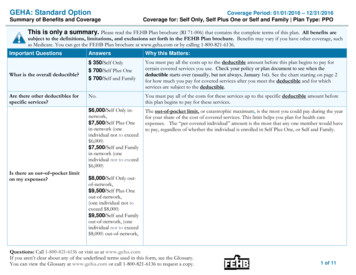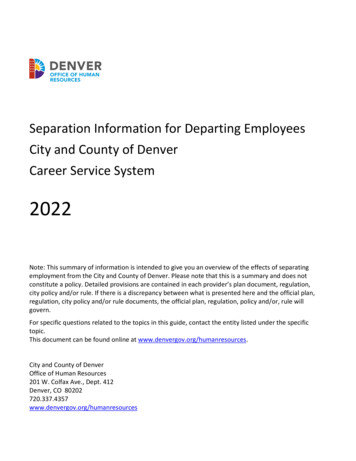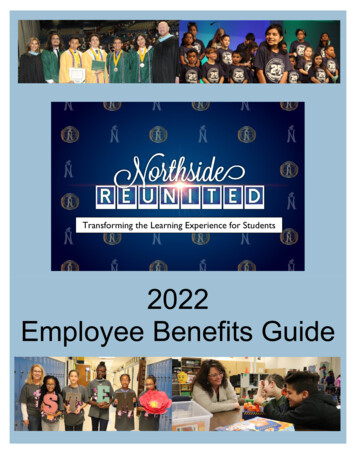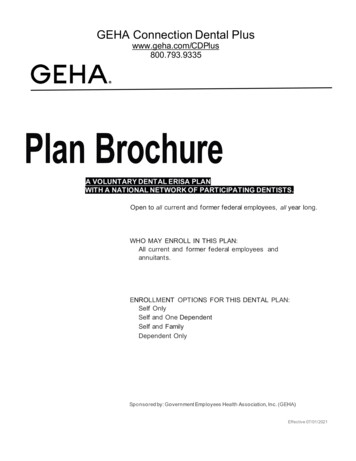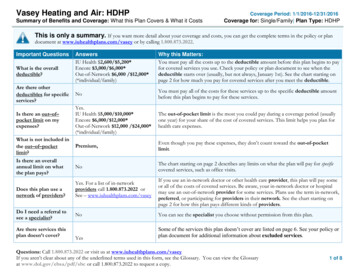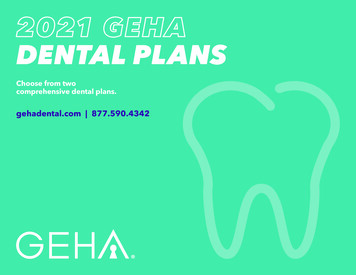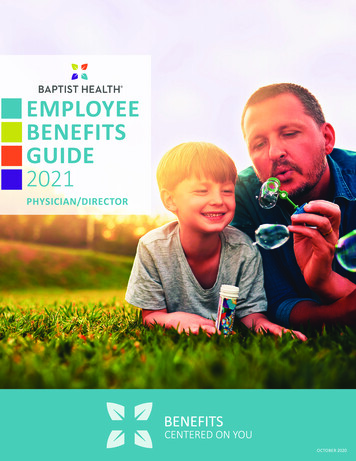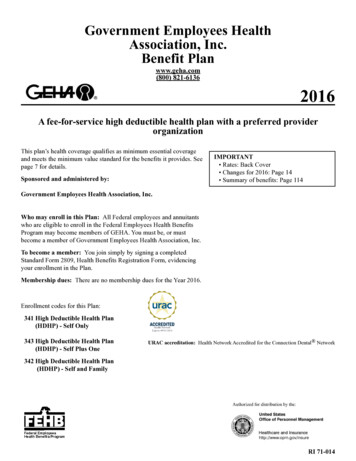
Transcription
Government Employees HealthAssociation, Inc.Benefit Planwww.geha.com(800) 821-61362016A fee-for-service high deductible health plan with a preferred providerorganizationThis plan’s health coverage qualifies as minimum essential coverageand meets the minimum value standard for the benefits it provides. Seepage 7 for details.Sponsored and administered by:IMPORTANT Rates: Back Cover Changes for 2016: Page 14 Summary of benefits: Page 114Government Employees Health Association, Inc.Who may enroll in this Plan: All Federal employees and annuitantswho are eligible to enroll in the Federal Employees Health BenefitsProgram may become members of GEHA. You must be, or mustbecome a member of Government Employees Health Association, Inc.To become a member: You join simply by signing a completedStandard Form 2809, Health Benefits Registration Form, evidencingyour enrollment in the Plan.Membership dues: There are no membership dues for the Year 2016.Enrollment codes for this Plan:341 High Deductible Health Plan(HDHP) - Self Only343 High Deductible Health Plan(HDHP) - Self Plus OneURAC accreditation: Health Network Accredited for the Connection Dental Network342 High Deductible Health Plan(HDHP) - Self and FamilyRI 71-014
Important Notice from Government Employees Health Association, Inc. AboutOur Prescription Drug Coverage and MedicareOPM has determined that the Government Employees Health Association, Inc. prescription drug coverage is, on average,expected to pay out as much as the standard Medicare prescription drug coverage will pay for all plan participants and isconsidered Creditable Coverage. This means you do not need to enroll in Medicare Part D and pay extra for prescription drugcoverage. If you decide to enroll in Medicare Part D later, you will not have to pay a penalty for late enrollment as long asyou keep your FEHB coverage.However, if you choose to enroll in Medicare Part D, you can keep your FEHB coverage and your FEHB plan willcoordinate benefits with Medicare.Remember: If you are an annuitant and you cancel your FEHB coverage, you may not re-enroll in the FEHB Program.Please be advisedIf you lose or drop your FEHB coverage and go 63 days or longer without prescription drug coverage that’s at least as goodas Medicare’s prescription drug coverage, your monthly Medicare Part D premium will go up at least 1% per month for everymonth that you did not have that coverage. For example, if you go 19 months without Medicare Part D prescription drugcoverage, your premium will always be at least 19 percent higher than what many other people pay. You will have to paythis higher premium as long as you have Medicare prescription drug coverage. In addition, you may have to wait until thenext Annual Coordinated Election Period (October 15 through December 7) to enroll in Medicare Part D.Medicare’s Low Income BenefitsFor people with limited income and resources, extra help paying for a Medicare prescription drug plan is available.Information regarding this program is available through the Social Security Administration (SSA) online atwww.socialsecurity.gov, or call the SSA at (800) 772-1213, TTY: (800) 325-0778.You can get more information about Medicare prescription drug plans and the coverage offered in your area from theseplaces:Visit www.medicare.gov for personalized help,Call (800) MEDICARE (800) 633-4227, TTY: (877) 486-2048.
Table of ContentsIntroduction .3Plain Language .3Stop Health Care Fraud! .3Preventing Medical Mistakes .4FEHB Facts .7Coverage information .7 No pre-existing condition limitation.7 Minimum essential coverage (MEC) .7 Minimum value standard .7 Where you can get information about enrolling in the FEHB Program .7 Types of coverage available for you and your family .7 Family Member Coverage .8 Children’s Equity Act .9 When benefits and premiums start .9 When you retire .9When you lose benefits .10 When FEHB coverage ends .10 Upon divorce .10 Temporary Continuation of Coverage (TCC) .10 Finding replacement coverage .10 Health Insurance Marketplace .10Section 1. How this plan works .11General features of our High Deductible Health Plan (HDHP) .11How we pay providers .12Your rights .13Your medical and claims records are confidential .13Section 2. Changes for 2016 .14Program wide changes .14Changes to this Plan .14Section 3. How you get care .16Identification cards .16Where you get covered care .16 Covered providers.16 Covered facilities .16 Transitional care .17 If you are hospitalized when your enrollment begins.18You need prior Plan approval for certain services .18 Inpatient hospital admission (including Skilled Nursing Facility, Long Term Acute Care, Rehab Facility orResidential Treatment Centers) .18How to precertify an admission to a hospital, Skilled Nursing Facility, Long Term Acute Care, Rehab Facilityor Residential Treatment Centers .19 Non-urgent care claims .19 Urgent care claims .19 Concurrent care claims .20 Emergency inpatient admission .20 Maternity care .20 If your hospital stay needs to be extended .20 Other services that require prior approval .202016 GEHA Benefit Plan1Table of Contents
Radiology/Imaging procedures precertification .22 If your treatment needs to be extended .22If you disagree with our pre-service claims decision .22 To reconsider a non-urgent care claim .23 To reconsider an urgent care claim .23 To file an appeal with OPM .23Section 4. Your costs for covered services .24Coinsurance .24Cost-sharing .24Deductible .24If your provider routinely waives your cost .24Waivers .25Differences between our allowance and the bill .25Your catastrophic protection out-of-pocket maximum for deductibles and coinsurance.25Carryover .26If we overpay you .26When Government facilities bill us .26Section 5. High Deductible Health Plan Benefits .27Non-FEHB benefits available to Plan members .87Section 6. General exclusions - services, drugs and supplies we do not cover .89Section 7. Filing a claim for covered services .91Section 8. The disputed claims process.93Section 9. Coordinating benefits with Medicare and other coverage .96When you have other health coverage or auto insurance.96 TRICARE and CHAMPVA .96 Workers’ Compensation .96 Medicaid .96When other Government agencies are responsible for your care .97When others are responsible for injuries.97When you have Federal Employees Dental and Vision Insurance Plan (FEDVIP) .98Clinical trials .98When you have Medicare .98 What is Medicare? .98 Should I enroll in Medicare? .99 The Original Medicare Plan (Part A or Part B).99 Tell us about your Medicare coverage .100 Private contract with your physician .100 Medicare Advantage (Part C) .100 Medicare prescription drug coverage (Part D) .100When you are age 65 or over and do not have Medicare .102When you have the Original Medicare Plan (Part A, Part B, or both) .103Section 10. Definitions of terms we use in this brochure .104Section 11. Other Federal Programs.110The Federal Flexible Spending Account Program – FSAFEDS .110The Federal Employees Dental and Vision Insurance Program – FEDVIP .111The Federal Long Term Care Insurance Program – FLTCIP .111Index .112Summary of benefits for the HDHP of the Government Employees Health Association, Inc. 2016.1142016 Rate Information for Government Employees Health Association, Inc. (GEHA) Benefit Plan .1182016 GEHA Benefit Plan2Table of Contents
IntroductionThis brochure describes the benefits of Government Employees Health Association, Inc. under our contract (CS 1063) with theUnited States Office of Personnel Management, as authorized by the Federal Employees Health Benefits law. This Plan isunderwritten by Government Employees Health Association, Inc. Customer service may be reached at (800) 821-6136 or through ourwebsite: www.geha.com. The address for the Government Employees Health Association, Inc. administrative offices is:Government Employees Health Association, Inc.P.O. Box 4665Independence, Missouri 64051-4665This brochure is the official statement of benefits. No verbal statement can modify or otherwise affect the benefits, limitations, andexclusions of this brochure. It is your responsibility to be informed about your health benefits.If you are enrolled in this Plan, you are entitled to the benefits described in this brochure. If you are enrolled in Self and Family orSelf Plus One coverage, each eligible family member is also entitled to these benefits. If you enroll in Self Plus One coverage, youand one eligible family member that you designate when you enroll are entitled to these benefits. You do not have a right to benefitsthat were available before January 1, 2016, unless those benefits are also shown in this brochure.OPM negotiates benefits and rates with each plan annually. Benefit changes are effective January 1, 2016, and changes aresummarized on page 14. Rates are shown at the end of this brochure.Coverage under this plan qualifies as minimum essential coverage (MEC) and satisfies the Patient Protection and Affordable CareAct’s (ACA) individual shared responsibility requirement. Please visit the Internal Revenue Service (IRS) website at idual-Shared-Responsibility-Provision for more information on the individual requirementfor MEC.The ACA establishes a minimum value for the standard of benefits of a health plan. The minimum value standard is 60% (actuarialvalue). The health coverage of this plan does meet the minimum value standard for the benefits the plan provides.Plain LanguageAll FEHB brochures are written in plain language to make them easy to understand. Here are some examples: Except for necessary technical terms, we use common words. For instance, “you” means the enrollee or family member, “we”means Government Employees Health Association, Inc. We limit acronyms to ones you know. FEHB is the Federal Employees Health Benefits Program. OPM is the United States Officeof Personnel Management. If we use others, we tell you what they mean. Our brochure and other FEHB plans’ brochures have the same format and similar descriptions to help you compare plans.Stop Health Care Fraud!Fraud increases the cost of health care for everyone and increases your Federal Employees Health Benefits Program premium.OPM’s Office of the Inspector General investigates all allegations of fraud, waste, and abuse in the FEHB Program regardless of theagency that employs you or from which you retired.Protect Yourself From Fraud – Here are some things that you can do to prevent fraud: Do not give your plan identification (ID) number over the telephone or to people you do not know, except for your health careprovider, authorized health benefits plan, or OPM representative. Let only the appropriate medical professionals review your medical record or recommend services. Avoid using health care providers who say that an item or service is not usually covered, but they know how to bill us to get it paid. Carefully review explanations of benefits (EOBs) statements that you receive from us.2016 GEHA Benefit Plan3Introduction/Plain Language/Advisory
Periodically review your claims history for accuracy to ensure we have not been billed for services that you did not receive. Do not ask your doctor to make false entries on certificates, bills or records in order to get us to pay for an item or service. If you suspect that a provider has charged you for services you did not receive, billed you twice for the same service, ormisrepresented any information, do the following:- Call the provider and ask for an explanation. There may be an error.- If the provider does not resolve the matter, call us at (800) 821-6136 and explain the situation.- If we do not resolve the issue:CALL - THE HEALTH CARE FRAUD HOTLINE(877) 499-7295OR go ort-fraud-waste-or-abuse/complaint-formThe online reporting form is the desired method of reporting fraud in order to ensure accuracy, and a quicker responsetime.You can also write to:United States Office of Personnel ManagementOffice of the Inspector General Fraud Hotline1900 E Street NW Room 6400Washington, DC 20415-1100 Do not maintain as a family member on your policy:- Your former spouse after a divorce decree or annulment is final (even if a court order stipulates otherwise); or- Your child over age 26 (unless he/she was disabled and incapable of self-support prior to age 26). If you have any questions about the eligibility of a dependent, check with your personnel office if you are employed, with yourretirement office (such as OPM) if you are retired, or with the National Finance Center if you are enrolled under TemporaryContinuation of Coverage. Fraud or intentional misrepresentation of material fact is prohibited under the Plan. You can be prosecuted for fraud and youragency may take action against you. Examples of fraud include falsifying a claim to obtain FEHB benefits, trying to or obtainingservice or coverage for yourself or for someone else who is not eligible for coverage, or enrolling in the Plan when you are nolonger eligible. If your enrollment continues after you are no longer eligible for coverage (i.e., you have separated from Federal service) andpremiums are not paid, you will be responsible for all benefits paid during the period in which premiums were not paid. You maybe billed by your provider for services received. You may be prosecuted for fraud for knowingly using health insurance benefits forwhich you have not paid premiums. It is your responsibility to know when you or a family member is no longer eligible to use yourhealth insurance coverage.Preventing Medical MistakesAn influential report from the Institute of Medicine estimates that up to 98,000 Americans die every year from medical mistakes inhospitals alone. That’s about 3,230 preventable deaths in the FEHB Program a year. While death is the most tragic outcome, medicalmistakes cause other problems such as permanent disabilities, extended hospital stays, longer recoveries, and even additionaltreatments. By asking questions, learning more and understanding your risks, you can improve the safety of your own health care, andthat of your family members. Take these simple steps:1. Ask questions if you have doubts or concerns. Ask questions and make sure you understand the answers.2016 GEHA Benefit Plan4Introduction/Plain Language/Advisory
Choose a doctor with whom you feel comfortable talking. Take a relative or friend with you to help you ask questions and understand answers.2. Keep and bring a list of all the medicines you take. Bring the actual medicines or give your doctor and pharmacist a list of all the medicines and dosage that you take, including nonprescription (over-the-counter) medicines and nutritional supplements. Tell your doctor and pharmacist about any drug, food, and other allergies you have, such as latex. Ask about any risks or side effects of the medication and what to avoid while taking it. Be sure to write down what your doctor orpharmacist says. Make sure your medicine is what the doctor ordered. Ask the pharmacist about your medicine if it looks different than youexpected. Read the label and patient package insert when you get your medicine, including all warnings and instructions. Know how to use your medicine. Especially note the times and conditions when your medicine should and should not be taken. Contact your doctor or pharmacist if you have any questions.3. Get the results of any test or procedure. Ask when and how you will get the results of tests or procedures. Don’t assume the results are fine if you do not get them when expected, be it in person, by phone, or by mail. Call your doctor and ask for your results. Ask what the results mean for your care.4. Talk to your doctor about which hospital is best for your health needs. Ask your doctor about which hospital has the best care and results for your condition if you have more than one hospitalto choose from to get the health care you need. Be sure you understand the instructions you get about follow-up care when you leave the hospital.5. Make sure you understand what will happen if you need surgery. Make sure you, your doctor, and your surgeon all agree on exactly what will be done during the operation. Ask your doctor, “Who will manage my care when I am in the hospital?” Ask your surgeon:-“Exactly what will you be doing?”“About how long will it take?”"What will happen after surgery?”“How can I expect to feel during recovery?” Tell the surgeon, anesthesiologist, and nurses about any allergies, bad reactions to anesthesia, and any medications or nutritionalsupplements you are taking.Patient Safety Links www.ahrq.gov/consumer/. The Agency for Healthcare Research and Quality makes available a wide-ranging list of topics not onlyto inform consumers about patient safety but to help choose quality health care providers and improve the quality of care youreceive. www.npsf.org. The National Patient Safety Foundation has information on how to ensure safer health care for you and your family. www.talkaboutrx.org. The National Council on Patient Information and Education is dedicated to improving communication aboutthe safe, appropriate use of medicines.2016 GEHA Benefit Plan5Introduction/Plain Language/Advisory
www.leapfroggroup.org. The Leapfrog Group is active in promoting safe practices in hospital care. www.ahqa.org. The American Health Quality Association represents organizations and health care professionals working toimprove patient safety.Never EventsWhen you enter the hospital for treatment of one medical problem, you don’t expect to leave with additional injuries, infections orother serious conditions that occur during the course of yo
2016 . A fee-for-service high deductible health plan with a preferred provider . You can get more information about Medicare prescription drug plans and the coverage offered in your area from these places: Visit www.medicare.gov for personalized help, . Our brochure and other FEHB plans' brochures have the same format and similar .
